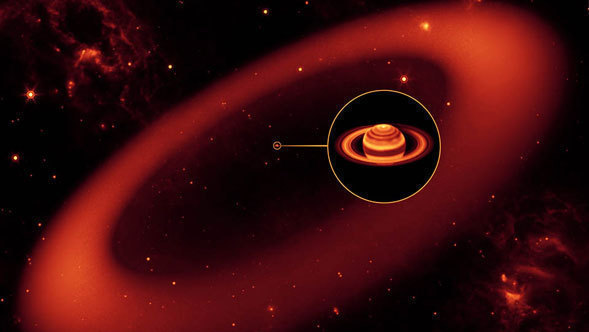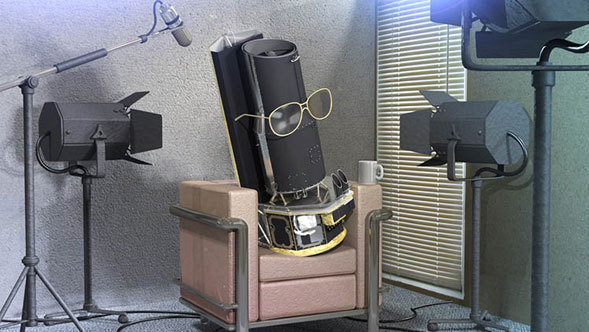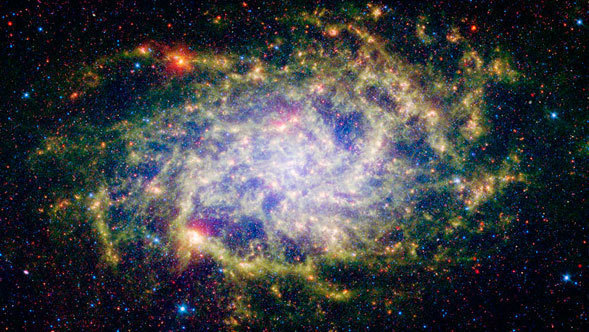Displaying news 301 - 330 of 587 in total
The Chandra X-ray Observatory Center
Peering far beyond our solar system, NASA researchers have detected the basic chemistry for life in a second hot gas planet, advancing astronomers toward the goal of being able to characterize planets where life could exist. The planet is not habitable but it has the same chemistry that, if found around a rocky planet in the future, could indicate the presence of life.
NASA's Spitzer Space Telescope has discovered an enormous ring around Saturn — by far the largest of the giant planet's many rings.
Astronomers have witnessed odd behavior around a young star. Something, perhaps another star or a planet, appears to be pushing a clump of planet-forming material around. The observations, made with NASA's Spitzer Space Telescope, offer a rare look into the early stages of planet formation.
Smoke and flames from the Station Fire are visible from the Spitzer Science Center, located on the campus of the California Institute of Technology.
A new study from two of NASA's Great Observatories provides fresh insight into how some stars are born, along with a beautiful new image of a stellar nursery in our Milky Way galaxy. The research shows that radiation from massive stars may trigger the formation of many more stars than previously thought.
NASA's Spitzer Space Telescope has found evidence of a high-speed collision between two burgeoning planets around a young star.
NASA's Spitzer Space Telescope is starting a second career and taking its first shots of the cosmos since warming up.
NASA's Spitzer Space Telescope has put its infrared eyes back on the sky to observe the cold and dusty universe.
NASA's Spitzer Space Telescope has imaged a wild creature of the dark — a coiled galaxy with an eye-like object at its center.
Testing and characterization activities continue for NASA's Spitzer Space Telescope warm mission, a process that began after the observatory's cryogen ran out on May 15.
On June 11th, Dr. Frank Low, one of the people responsible for the rise of infrared astronomy, died in Tucson. He was 75 years old.
The Chandra X-ray Observatory Center
Engineers and scientists are continuing with testing and characterization activities for the NASA Spitzer Space Telescope warm mission, a process that began after Spitzer's cryogen ran out on May 15.
Astronomers have at last uncovered newborn stars at the frenzied center of our Milky Way galaxy. The discovery was made using the infrared vision of NASA's Spitzer Space Telescope.
The Chandra X-ray Observatory Center
Characterization activities for NASA's Spitzer Space Telescope continue, a process that began after its cryogen ran out on May 15.
After more than five-and-a-half years of probing the cool cosmos, NASA's Spitzer Space Telescope has run out of the coolant that kept its infrared instruments chilled. The telescope will warm up slightly, yet two of its infrared detector arrays will still operate successfully. The new, warm mission will continue to unveil the far, cold and dusty universe.
Scientists have long wondered how tiny silicate crystals, which need sizzling high temperatures to form, have found their way into frozen comets, born in the deep freeze of the solar system's outer edges. The crystals would have begun as non-crystallized silicate particles, part of the mix of gas and dust from which the solar system developed.
The primary mission of NASA's Spitzer Space Telescope is about to end after more than five and a half years of probing the cosmos with its keen infrared eye. Within about a week of May 12, the telescope is expected to run out of the liquid helium needed to chill some of its instruments to operating temperatures.
NASA's Spitzer Space Telescope is about to use its last drop of the coolant that has chilled it for the past five-and-a-half years. On about May 12, give or take a week or so, the observatory is predicted to run out of the liquid helium that has run through its veins, keeping its infrared detectors at frosty operating temperatures of just a few degrees above the coldest temperature possible, called absolute zero.
Using NASA's Spitzer Space Telescope, an international team of astronomers has discovered streams of young stars flowing from their natal cocoons in distant galaxies. These distant rivers of stars provide an answer to one of astronomy's most fundamental puzzles: how do young stars that form clustered together in dense clouds of dust and gas disperse to form the large, smooth distribution seen in the disks of spiral galaxies like the Milky Way?
Using the infrared detectors on NASA's Spitzer Space Telescope, a team of researchers based in the U.K. and in the United States have placed new constraints on how often rocky planets like Earth may exist around stars other than our Sun.
Balloon-borne Large-Aperture Submillimeter Telescope
Life on Earth is thought to have arisen from a hot soup of chemicals. Does this same soup exist on planets around other stars? A new study from NASA's Spitzer Space Telescope hints that planets around stars cooler than our sun might possess a different mix of potentially life-forming, or "prebiotic," chemicals.
This new image of the Triangulum galaxy is being released as part of the 'Around the World in 80 Telescopes' event for the International Year of Astronomy.
A collection of NASA missions will be involved in a live event Friday, April 3, that will allow the public to get an inside look at how these missions are run. "Around the World in 80 Telescopes" is a 24-hour webcast that is part of the "100 Hours of Astronomy" event for the International Year of Astronomy 2009.
A new image from NASA's Spitzer Space Telescope offers a rare view of an imminent collision between the cores of two merging galaxies, each powered by a black hole with millions of times the mass of the sun.
Using NASA's Spitzer Space Telescope, researchers have found evidence suggesting that stars rich in carbon complex molecules may form at the center of our Milky Way galaxy.
NASA's Spitzer Space Telescope has resumed normal operations after entering standby mode on Friday, Feb. 27, 2009, at 8:41a.m. Pacific Standard Time.
Displaying news 301 - 330 of 587 in total





























